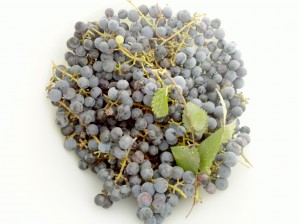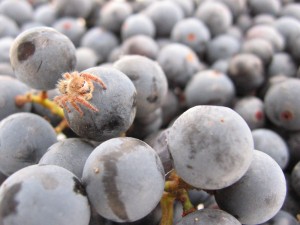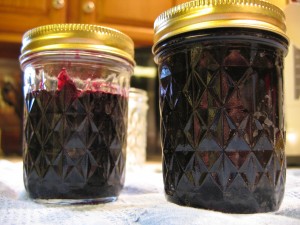Back when Summer was slowly winding down, I finally got myself out and went Concord grape picking as I had jelly on my mind. It just so turns out that there are several places within walking distance from my house that have the vines growing all over the place.
I know, I know it is easy enough to just grab the ubiquitous, ready made, purple stuff from the supermarket, but
- that would be too easy and
- the taste of wild grapes has gobs more flavor.
Gobs more flavor if picked at the right time that is…I think I had a few too many under ripe, tart grapes. I also didn’t have the time to go foraging for as many grapes as specified in the recipe…grumble, grumble, blah. As patience was never one of my most shining virtues, I gave it the old college try anyway.
What follows are snippets from my localvore, microbatch jelly making session.
Recipes
As far as recipes go, the Ball Blue Book has a lot of recipes and general info. As the book doesn’t cost much, I highly recommend it as it is valuable if you are just starting with preserving and canning.
However, I was looking for something a little different. After some searching I stumbled across one from Nina Corbett’s Put Up or Shut Up! site and is the one I used here.
Got grapes?
Before moving to our new house a few years back, my wife and I were living in a house apartment. Our landlords were Portuguese and they had a picnic table area surrounded by a canopy of Concord grape vines. When the grapes were getting close to being ripe and pickable, they gave off a very intriguing smell.
The husband Angelo would tend the vines throughout the year and when enough grapes could be picked, his brother-in-law would come over and they would make wine. I could only imagine what that concoction tasted like, but they gave me a batch of extra grapes one year and that was my first experience with making homemade grape jelly.
Since then, I have been able to recognize that distinctive smell during late summer and it has gotten easier and easier to identify the vines when out on walks or even driving around in the car.
Some stores will sell clusters of Concord grapes in season, but if you get a chance and they grow in your area, go out and get yourself to pickin! For general info, here is a good place to start.
Read the recipe
Once you have a recipe you are ready to try, read the instructions thoroughly to make sure you aren’t forgetting anything…before you get started. Once things get going, running around looking for some ingredient or utensil can be nerve wracking and is an inefficient way of working in the kitchen.
The general gist of your standard jelly recipe is the ratio of extracted grape juice to added sugar. Also, it is usually true that additional pectin is required if shorter gel times and less sugar are used.
Prep the fruit
My rule of thumb for prepping fruit is “If I wouldn’t eat the fruit out of hand because of its condition then it isn’t good enough to put in whatever I am cooking” . Better yet, leave ill-shaped and questionable grapes right where you originally found them…on the vine.
Whether store bought or wild picked, give your fruit a good washing, to free loose debris and what not. You never know what stowaways may be lurking about:
Get to boiling
Once the requisite grape juice is extracted, let the games begin! Add the ingredients and bring to a boil. As is often brought up, the grape juice will stain pretty much anything it comes in contact with. Here I am using a stain/heat resistance spatula to keep things moving:
For this recipe, no additional pectin was used. The key for making sure the jelly will set up is ensuring that the gel point is reached (220 deg F.)
You can use a candy thermometer to make sure it is good to go. I actually “eyed” the proper time to stop boiling, by noting the distinct change in appearance of the boiling jelly bubbles. There will be a noted change in the viscosity of the liquid. Please see the aforementioned Blue Book for other methods to determine whether the proper gel will be achieved.
Can it up
The next step is to put the resulting sugary goodness into sterilized jars for storing. Timing is crucial once the gel point is reached, so make sure that the jars are ready. The hotter the jelly, the easier it will be to fill the jars. If I happen to have a jar that isn’t filled to the top, I just store it in the fridge without processing and start enjoying once it has set up. Once all the jelly has been distributed, then process the jelly as per the recipe instructions.
Enjoy
It is usually prudent to let the jelly continue to set up for a day or two after canning…
for optimal eating pleasure:





